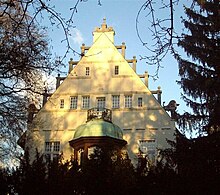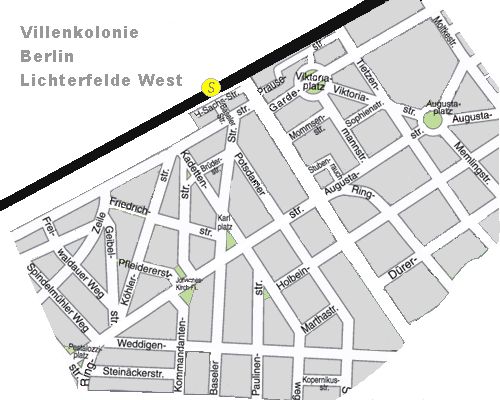Lichterfelde villa colony

The villa colony of Lichterfelde , also known as Carstenn's villa colony , located in the Berlin district of Lichterfelde (since 1920 part of Greater Berlin , Steglitz district, since 2001 part of the Steglitz-Zehlendorf district ), was planned as one of the first villa colonies in the German Reich from 1865 and is one of the oldest residential areas in Berlin.
development
The Hamburg businessman Johann Anton Wilhelm von Carstenn was traveling through the UK there learned the residential area located on the outskirts of cities and decided those neighborhoods with in Germany villas to apply for prestigious living in the countryside. According to Carstenn's ideas, these settlements should form an architecturally cohesive whole and enable their residents to achieve an upscale lifestyle with their own small business center. After the successful establishment of the Marienthal villa colony near Wandsbek , Carstenn also planned to create villa colonies in the southwest of the expanding capital of Berlin. In his search for a suitable plot of land for the residential areas embedded in green and water areas, Carstenn chose the heavily indebted manors Lichterfelde and Giesensdorf , as well as the manor Wilmersdorf near Berlin, which he acquired with profits from Wandsbek in 1865 .
Carstenn developed a new concept for the implementation of his idea: his company opened up the area with road and rail systems, which provided for a regular arrangement of streets and squares in the form of an urban figure (see: Carstenn figure ). The demand for the parceled plots was initially very high, fueled by a wide range of advertising measures, but soon the project got caught up in the vortex of the founders' squabble and stagnated. In order to increase the attractiveness of the new colony, Carstenn had given the Prussian state a plot of land on today's Finckensteinallee for the construction of the main cadet institute and also made significant funds available for the construction of the cadet institute. With the construction of the barracks of the Prussian Guard Rifle Battalion (on today's Gardeschützenweg), Carstenn also hoped to attract settlers from the Prussian officer corps and the higher civil service. In 1898 the new building of the Rother-Stift was inaugurated, which had been brought to life by royal decree in Berlin in 1842. The Rother-Stift was intended to provide accommodation for daughters of officers and civil servants in old age.
One of the first houses was Friedrich Drake's villa in Mühlenstrasse, today's Karwendelstrasse, which was soon followed by houses around Marienplatz near the Lichterfelde station on the Anhalter Bahn, the Berlin – Halle railway line , which opened in 1868 . It was noteworthy that the young community wanted to build a school as the first public building, which later became the Schiller Gymnasium from 1884. The Teltow district administration showed complete incomprehension. Lichterfelde also prevailed because of some private funds used. The Rathaus-Lichterfelde was not completed until 1894.
Up until around 1900, a district was built in several construction phases, which, with its mix of diverse architectural styles, avenues, small squares and large gardens, met the representational demands of the Wilhelminian bourgeoisie and its longing for idylls in equal measure. To this day, villas of the most important varieties of historicism have been preserved:
Eclectic buildings in Wilhelmine style can be found next to neo-Romanesque or neo-Gothic houses. Some villas have soaring “ Gothic ” pointed gables and towers, other columns and “ Baroque ” sculptural decorations on the entrance stairs, and still others are clearly influenced by Art Nouveau . Typical are the mezzanine floor (“ Beletage ”), the coach house in the courtyard or garden and the “Lichterfelder Türmchenvillen” at all important places or intersections. Also known are the “castle villas” designed by the architect Gustav Lilienthal , brother of the aviation pioneer Otto Lilienthal , in a fantasy style with neo-Gothic elements based on the model of English country houses in the New Tudor style . Gustav Lilienthal lived at Tietzenweg 51 (formerly: Dahlemer Straße 22), later at Marthastraße 5 until his death. Otto Lilienthal's house at Boothstraße 17 has not been preserved.

Carstenn planned the shopping district around Drakestrasse and what is now the Lichterfelde West S-Bahn station , while Drakestrasse itself was planted with specially imported tropical and subtropical trees and bushes as part of the enthusiasm for everything exotic from the young overseas colonies , which, however, did not suit the climate in Berlin held out for a long time. Carstenn praised his colony in his advertising brochures as "one of the most beautiful villa locations in the German Empire ". The colonies of Lichterfeld became a model for other facilities in imperial Germany.
At the latest with the global economic crisis at the end of the 1920s, the costly maintenance of the villas, which required extensive staff, became increasingly difficult to finance for many of the owners. Since the colony had developed into a preferred residential area for the aristocratic Prussian officer corps due to its proximity to the cadet institute, both the losses of the First World War and the dissolution of the cadet institute hit particularly hard. The villa colony of Lichterfelde became known for its wealthy war widows ("Witwenfelde"). A visible change in population did not occur until after the Second World War . Often too large villas were divided into apartments to meet the changed demands, vacant lots torn by the war were partly filled with rental houses in response to the housing shortage of the post-war years . In the 1970s and 1980s, the citizens' initiative "Black Rose" fought successfully for the reinforcement of the monument protection in the district in order to put a stop to the increasing land speculation.
The closed character of the colony as a villa and garden city has been preserved to this day. The old cobbled streets , the old trees and the gas lighting , which was modernized in the 1920s, are mostly still intact. The tall Wilhelminian style houses and comparatively narrow tree-lined avenues still convey the “ urban garden city atmosphere” typical of the 19th century , which differs significantly from the village-like villa settlements of the early 20th century. The historic shopping area around the Lichterfelde West train station has also been renovated and is an architectural and urban gem . To this day, however, many of the original square designs with fountains, flower beds and benches that originally shaped the quarter have not been restored.
Since the fall of the Berlin Wall , the former villa colony of Lichterfelde has been experiencing extremely lively restoration work ; many villas have been renovated and are being used again according to their traditional purpose. The quarter is very popular with diplomats who appreciate the Lichterfeld villas for their representational purposes and who use the rapid connection to the center and the government quarter that has been restored since the fall of the Berlin Wall .
Villa in Art Nouveau
"Burg-Villa" by Gustav Lilienthal
Historical descriptions
The villa colony of Lichterfelde experienced its first boom in the early days up to the founder crash of 1873. Ulrich Muhs describes the development in 1919 as follows:
“In other ways, too, interest in the settlement had been aroused. It had already started to warm to it in the higher circles of society. The noble world of Berlin found itself there numerous on weekdays and Sundays on wagons and horses. Often enough, no fewer than 500–600 equipages were counted in one day at the little road house in Steglitz , all of which drove to Lichterfelde. The pavilion restaurant with its large, shady garden was soon opened and rose surprisingly quickly. At that time the days were splendid and it was furnished in the most elegant fashion. Well-dressed servants stood at the entrances and blocked entry to anyone who did not identify themselves as belonging to society by their appearance or appearance. Berlin and Potsdam bands gave concerts outdoors. Various other events were also held to entertain the public, as was the park behind his castle, which was approved by Carstenn, which was visited with preference. In short, there was a big city hustle and bustle in the small village that was now almost unimaginable. "
Paul Lüders wrote in 1893:
“The generosity was so lavish in individual places, especially on Drakestrasse, that the most magnificent park grew up as if by magic on the previously bare land […] Unfortunately, many of the noble plants later perished again. In the poor soil and the harsh climate, the foreign plants in particular were unable to grow [...] "
Tours
The villa colony of Lichterfelde extends about a kilometer on both sides of Drakestrasse. In the north, the district boundary between Dahlem and Lichterfelde-West runs along the Unter den Eichen and Altensteinstrasse. In the south, the quarter extends to Finckensteinallee. According to the historical building development, there are fewer clear boundaries to the west and east. The construction phases of the 1920s follow on from the Wilhelminian style. In the north and south, around the Lichterfelde West S-Bahn station , on both sides of Drakestrasse and in Gardeschützenweg, there is an increasing number of apartment and commercial buildings.
To explore the district, you can start at the Lichterfelde West station of the Berlin S-Bahn (line S1, approx. 15 minutes travel time from Potsdamer Platz ). A short tour (approx. 20 minutes) from there leads south past the historical buildings of the Westbazaar, across Curtiusstrasse, half-right through Baseler Strasse to Karlsplatz. At Karlsplatz half left, cross the Ringstrasse , into Kadettenweg. Head south on Kadettenweg past the memorial stone for the Prussian Cadet Corps , then right into Weddigenweg, short detour into Paulinenstrasse to the Lilienthal castles, back and on on Weddigenweg, across Baseler Strasse, right into Kommandantenstrasse North. At Johanneskirchplatz cross the Ringstraße again, follow the Kommandantenstraße half right, past the historic Rother-Stift , cross Friedrichstraße, continue until Kommandantenstraße meets the Kadettenweg again (north end), then follow Kadettenweg only a few more meters to Curtiusstraße, turn right, Curtiusstraße follow to the Westbazaar, then left back to the S-Bahn station Lichterfelde West.
Main entrance to Rother-Stift
literature
- Committee for Local Interests (Ed.): Guide through Gross-Lichterfelde. 1901.
- as a reprint : Hildebrand, Berlin 1989, ISBN 3-923164-09-2 .
- Uta Lehnert: A voice for the dead. Lichterfelde park cemetery. Edition Hentrich Druck, Berlin 1999, ISBN 3-89468-204-3 .
- Paul Lüders, Hans P. Heinicke (Ed.): Liebling Lichterfelde. Chronicle of Lichterfelde. Accurat Tb, ISBN 3-926578-46-7 .
- Ulrich Muhs: Lichterfelde then and now. Architecture publisher “Der Zirkel”, Berlin 1919.
- Peter Murr: Behind the red walls of Lichterfelde. Amalthea Verlag, 1931.
- Julius Posener: Berlin on the way to a new architecture. The Age of Wilhelm II. Berlin 1979, ISBN 3-7913-0419-4 . 2nd edition, Prestel, Munich / New York 1995.
- Erika Reinhold, Reinhard Ilgner: Lichterfelde. From the village to the suburb of Berlin. Bodenbender, 2003, ISBN 3-00-010625-1 .
- Erika Reinhold, Reinhard Ilgner: Lichterfelde II. In the shadow of the world wars. ISBN 3-926578-49-1 .
- Burkhard Sonnenstuhl: Celebrities in Lichterfelde. Bebra Verlag, 2008.
- Ignaz Urban : Flora from Groß-Lichterfelde and the surrounding area . In: Negotiations of the Botanical Association for the Province of Brandenburg. 22nd year, Berlin 1881, p. 26 ff. Digitized
- Thomas Wolfes: The villa colony of Lichterfelde - On the history of a Berlin suburb (1865-1920) . University press of the TU Berlin, Berlin 1997, ISBN 3-7983-1722-4 .
Web links
- Tour 06: In the footsteps of Carstenn and Lilienthal. A hike in the villa colony of Lichterfelde-West . Kulturfuehrer-berlin.de.
Individual evidence
- ↑ Berlin-Steglitz 750 Years of Berlin 1987, Steglitz District Office of Berlin, 1987, p. 103
Coordinates: 52 ° 26 ′ 10 " N , 13 ° 17 ′ 43" E











